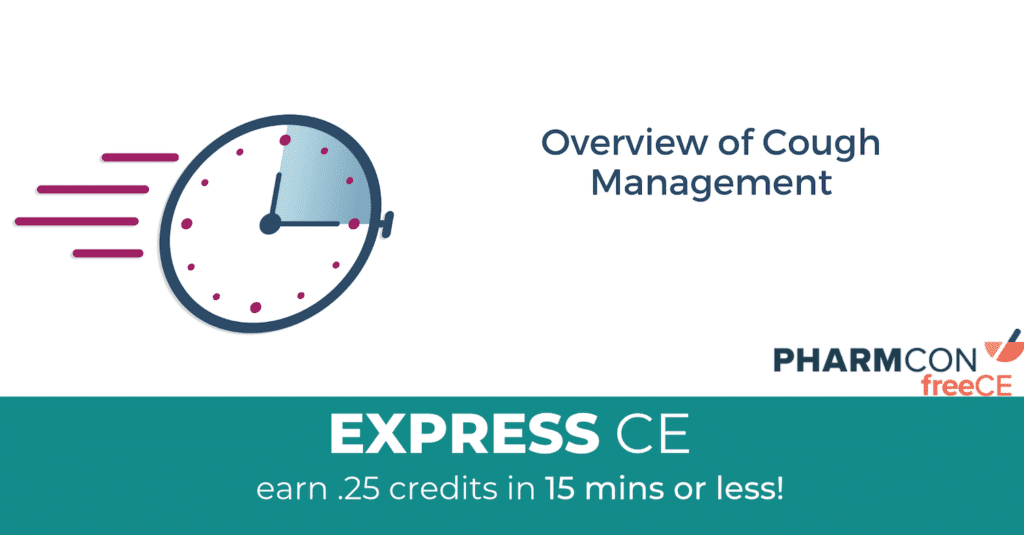How well I remember back in the 1980’s buying Robitussin AC®, Robitussin DAC®, Phenergan with codeine® and Phenergan VC with codeine® in GALLON jugs! Dispensing 8 oz of these codeine containing cough suppressants was typical during flu season. Pediatricians would even prescribe Tussionex ® to stop the nighttime coughing! How the landscape has changed!
I have also had more than a few patients present with the nighttime cough, more like a “tickle” from ACE inhibitors. Switching them to an angiotensin receptor blocker took care of the annoying cough. As my favorite allergist once said, “ I seldom prescribe cough syrups; it is my job to figure out what the etiology of the cough is.”
Table of Contents
COUGH–should we even treat it?
The tree pollens are flying now, soon to be joined by the grass pollens and later on in the year, ragweed will be blooming. We’ve been cooped up all winter long and most of us are ready to be outside picking up sticks and tree limbs from those spring winds. Those winds are also carrying tree pollen as well.
Your patients are ready to open the windows and let in the “fresh air” as well as the tree pollens. When those tree pollens get into our nose and lungs and stick to our mucus membranes, we can expect an “allergy cough” to occur. Asthma and allergy coughs are typically caused by swelling or irritation of the airways. Allergies like hay fever can cause a chronic dry cough. If your patient is sensitive to dust, pet dander, pollen, mold, or other common allergens, then their allergy symptoms may include a cough.
Key points to consider when a patient presents with a cough are:
- Cough is only a symptom of an underlying problem, that can range from benign and self-resolving, to chronic or even life threatening, depending on the condition of the patient and comorbid illness. Effective treatment always addresses the underlying cause of the cough.
- Cough is a physiologically protective reflex, which assists in clearing the respiratory tract of mucus, inhaled irritants, and other foreign debris.
- Coughing is sometimes both useless and distressing and can physically and psychologically exhaust the patient. Cough suppression is then warranted.
Cough basics:
Coughing from the common cold is usually caused by stimulation of cough receptors in the epithelial lining of the tracheobronchial tree. The cough center, located in the medulla, coordinates the events that lead to a cough response. Coughs can be productive or non-productive.
Effective cough depends on:
- Intact afferent-efferent reflex arc
- Adequate expiratory and chest wall muscle strength
- Normal mucociliary production and clearance.
- Abrupt contraction of respiratory muscles leads to an explosive rise in intrathoracic pressure which forces air out of the alveoli and through the airways.
Questions to ask your patient:
- How long has the cough been present?
- Did it begin suddenly?
- Did it recently change?
- What factors influence it? (Such as cold, posture, talking, time of day and eating or drinking).
- Is it associated with sputum production, pain, hoarseness & dizziness?
- Are there any other symptoms indicating serious disease?
- Fever/chills, hemoptysis (coughing up blood), recent unexplained weight loss, dyspnea (shortness of breath), orthopnea (shortness of breath when laying flat), pedal edema?
When not to self-treat:
One of the local allergists told me at a conference that he never writes for any cough syrup. He said a cough was a symptom of something that needs to be fixed. He said that the cough was the body’s way of getting rid of something that shouldn’t be in the lungs. A chronic cough needs a full workup for asthma or chronic obstructive pulmonary disease (COPD)
- Rule out ACE inhibitor use!! Check their med list for lisinopril, enalapril, quinapril etc. A meta-analysis of 29 studies showed that cough occurs in 9.9% of patients we treat with ACE inhibitors.
- Inhaled irritants to lungs (dust, smoke)
- Kids under age 4
- Check for history of COPD, asthma, congestive heart failure.
- Cough over 7 days or gets worse.
- Refer if short of breath, chest pains, ankle swelling, hemoptysis, fever over 103 for adults; fever over 102 for kids >4yrs.
- These patients should be referred to their provider for follow up care.
TREATMENT OF COUGH-Two Targets
There are central and sensor components to the reflex arc that are targets for drugs to suppress the cough.
- CENTRAL SITE: Drugs that suppress the sensitivity in the cough center located in the medulla. (central site) Examples: codeine (rx), hydrocodone (rx), dextromethorphan, diphenhydramine.
- PERIPHERAL SITES: Receptor activation and activity in the afferent nerves. Receptors are located in the epithelial lining of the tracheobronchial tree. Examples: menthol, camphor, benzocaine, benzonatate (rx)
Cough Drops
Representative Products: Halls Mentho-Lyptus®, Celestial seasonings®, Fisherman’s Friend®
- MECHANISM OF ACTION: act peripherally on the sensory nerve receptor. Produce a sensation of coolness on the respiratory tract, presumably by stimulating cold sensory receptors. This engenders a local anesthetic effect, thus is an antitussive. Also, may coat mucosa and prevent irritation.
Patient Counseling Points for Cough Drops
- Stop using if cough is more than 7 days.
- Sore throat warning: if persists more than 2 days, accompanied by fever, headache & nausea, consult practitioner.
- Use sugar free lozenges if diabetic.
- Sugar consumption may increase dental caries.
- Caution with small children (choking hazard)
Sore Throat Lozenges
Representative products: Benzocaine, Phenol, Lidocaine, Benzyl alcohol. Found in : Chloraseptic®, Cepastat®, Cepacol®
MECHANISM OF ACTION: “numb” the cough receptors with which they come in contact with.
PATIENT EDUCATION
- Most singers, when they have a sore throat, are trained to avoid “phenol” as well as other local anesthetics. Vocal cord damage can occur, if they use these products, and “push” their voice, and do damage to their vocal cords. Most laryngologists recommend pectin cough drops.
- Mild GI upset can occur.
HONEY (source: Medical Letter Dec 17,2018)
- A single 10 gm dose of honey relieves airway irritation and decreases cough. Comparative studies to dextromethorphan show it is as effective.
- Avoid in children under age-1 due to potential infantile botulism.
Prescription Treatment of Cough
We dispense a lot of cough suppressants when the OTC preps are ineffective. We have two entirely different cough suppressants available by prescription only. Both are swallowed, but one works centrally and the other locally in the lungs.
BENZONATATE was first approved in 1958 as Tessalon® perles and is available in 100mg and 200mg capsules. Dosed three times daily for a maximum of 600mg per day.
MECHANISM OF ACTION: acts peripherally by anesthetizing the stretch receptors located in the respiratory passages, lungs and pleura by dampening their activity. It begins to work within 15 to 20 minutes and its effects lasts for 3 to 8 hours. Has NO inhibitory effect on the respiratory center in recommended dosages.
WARNINGS/ PRECAUTIONS/ ADVERSE EFFECTS: SEVERE hypersensitivity reactions (bronchospasm, laryngospasm and cardiovascular collapse) have been reported when chewing the capsule instead of swallowing it whole! Choking can occur if capsule is bitten or chewed. I counsel my patients to swallow it whole with a cold glass of water. May cause sedation, headache, dizziness, constipation, nausea and GI upset.
The Medical Letter back in February 2010 reported that of ingestion in children under 10 years of age may be fatal. One or two capsules in a 2-year-old or younger has caused fatalities. May cause seizures, cardiac arrhythmias and death. Remind patients to keep out of reach of small children.
OPIOID DERIVATIVES (CODEINE & HYDROCODONE)
Codeine ( 3-methylmorphine) is the “gold standard” for treating cough; all other anti-tussives are measured against codeine for effectiveness. The dose is 10-20mg every 4-6 hours which is half of the analgesic dose. Some physicians will prescribe 30 to 60mg per dose due to lack of efficacy of the lower dose. Codeine is available OTC in 28 states.
Codeine gets converted to morphine by CYP450-2D6. This has great variability between patients and can result in either no efficacy, or respiratory depression.
CODEINE CAUTION:
Codeine is demethylated to morphine for analgesic and cough suppressing effect. Codeine is less potent than morphine (affinity for μ-opioid receptor 200 fold weaker)
30mg Morphine= 200mg codeine
Poor metabolizers (those who cannot activate codeine to morphine) may see a lack of analgesic effect. However, ultra rapid metabolizers may see severe or life-threatening side effects such as apnea or respiratory depression.
Phenotype | Expected Result | Prevalence |
Poor metabolizer | No codeine analgesia | 5-10% |
Intermediate metabolizer | Some analgesia | 2-11% |
Extensive metabolizer | Acceptable analgesia | 77-92% |
Ultra-Rapid metabolizer | Serious side effects, respiratory depression | 1-2% |
AVAILABLE AS: Guaifenesin/codeine; Promethazine/codeine; Promethazine VC/codeine each contains 10mg of codeine per teaspoonful. Clinicians should not prescribe more than 4-6 ounces at a time to prevent the potential of overdose. Pharmacists should offer to provide a measuring device and encourage patients to use it.
MECHANISM: centrally mediated suppression of cough threshold. Binds to opiate receptors in the cough center. Codeine is a prodrug that is converted to morphine by the hepatic enzyme CYP2D6. However, genetic variability causes some patients to metabolize it too slowly, and others to metabolize it too quickly. Some patients, particularly children and individuals with obstructive sleep apnea, are “ultrarapid metabolizers,” who experience sometimes fatal respiratory depression after taking therapeutic doses of the medication, because they convert the codeine to morphine too rapidly.
Warnings: An FDA advisory committee recommended against the use of codeine for treatment of cough in children in December 2015. In September 2016, the American Academy of Pediatrics recommended against using codeine in children either for pain or as an antitussive. Is best not to prescribe codeine for any patient under age 18.
EFFICACY: According to an article published in the British Medical Journal, codeine lacks any clinically significant efficacy to control coughs.
(Source: Morice A, Kardos P. Comprehensive evidence-based review on European antitussives. BMJ Open Respiratory Research 2016;3:e000137. doi: 10.1136/bmjresp-2016-000137)
HYDROCODONE: Hydrocodone gets metabolized to an active metabolite hydromorphone by CYP2D6 as well. Ultra-rapid metabolizers would expect to see an increase effect and increase in toxicities with hydrocodone.
AVAILABLE AS Hydromet® (hydrocodone/homatropine 5/1.5 per 5mL) and Tussionex® (hydrocodone/chlorpheniramine 10/8 per 5mL)
Again, clinicians should be cautious when prescribing appropriate quantities. When prescribing Tussionex®, keep in mind that the 4oz bottle has 24 doses (12-day supply) which most feel is an excessive duration. Pharmacists should provide a measuring device and encourage its use.
MEDICARE D PLANS DO NOT PAY FOR OPIOID CONTAINING COUGH SYRUPS! No plans pay for cough preparations over age 65.
Recommendations from the American College of Chest Physicians
(Evidence based guidelines) (as of Oct-2006)
Acute Cough due to the common cold:
Description: cough and throat clearing caused by a viral upper respiratory infection.
Treatment: first generation antihistamine/decongestant combination (Grade-A)
Cough due to acute bronchitis
Description : cough lasting up to 3 weeks caused by lower airway infection (usually viral)
Treatment: Short acting beta-2 agonists (Grade-C) Antitussives (Grade-C)
Cough Due to Chronic Bronchitis
Description: Chronic cough and sputum most days for 3 months. (smokers)
Treatment: Short acting Beta-2 agonist (Grade-A) Ipratropium (Grade-A)
ACEI (Angiotensin converting enzyme inhibitor) Cough.
Description: Dry, persistent cough or scratchy tingling sensation in throat beginning hours to months after ACE inhibition.
Treatment: Stop ACEI. Usually resolves in 1-4 weeks, may take 3 months to resolve.
Have a Great Day on the Bench!






